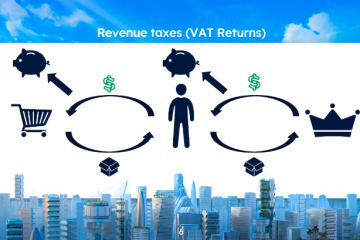The Dutch income tax is divided into 3 boxes. Box 1 is about income from work and contains a progressive tax rate system which implies that you have to pay more taxes in the case of a higher salary. Box 2 is about income from substantial interest in a domestic or foreign company and contains a flat rate of 26.90%. Directly or indirectly owning 5% or more of the shares in a company qualifies as substantial interest. That way dividend, capital gains or profit from owning those shares are being taxed at a flat rate of 26.90% of that profit.
Besides these two boxes there is a third box, box 3. This box is about income from assets: wealth tax. This blog will focus on how box 3 works, and anything you should know as a foreigner doing business or living in the Netherlands.
What is wealth tax?
The wealth tax in box 3 is meant for everybody with a wealth of more than €50.000.- in the Netherlands (since 2021, before it was €30.846.-). This means your private wealth, and does not apply to the wealth of your company. You are obligated to pay the taxes if you are a Dutch resident or if you’re a resident in another country but have wealth (properties for instance) in the Netherlands. The tax is meant mostly for savings and properties and is being calculated by subtracting your debts from your possessions. This means that any second houses you possess, and any shares, bonds or savings are added up and any debts like mortgages or any other loans are subtracted from this.
How do you know if you need to pay taxes in box 3?
If you want to know if you have to pay taxes you first need to have a clear view on what properties, shares and other possessions you have. Besides this you need to have a clear view on your debts as well.
If the total is more than €50.000.- you need to pay taxes in box 3. If you have a tax partner this amount is €100.000.- shared. Do you want to make sure your wealth is below or above this amount, but don’t have a clear view on your possessions and debts? Dutch bv can help you get a clear view and do your taxes correctly. Contact us if you need help!
How much tax do I need to pay in box 3?
Calculating how much tax you need to pay in box 3 can be very complex. This is due to a couple of factors. Firstly, there are 3 ‘discs’ which differ in the percentage of tax that needs to be paid. Which disc you need to pay tax in is dependent on the wealth you possess.
The discs all have a different percentage as tax rate, which is based on fictitious return. The fictitious return is based on the returns which is most common for wealth. It is a combination of investments and savings which is rated on forehand. All investments are taxed at 5.69% and all savings at 0.03%.
- In the first disc it is assumed that 67% of your wealth is savings and 33% investments, resulting in a combined tax rate of 1.9%.
- In the second disc it is assumed that 21% of your wealth is savings and 79% investments, resulting in a combined tax rate of 4.5%.
- In the third disc it is assumed that 100% of your wealth is investments, resulting in a tax rate of 5.69%.
It does not matter if this is your real income, that could be lower or higher. The fictitious income rates apply to everybody.
Calculation
To clear the above mentioned calculations up, we added an example calculation below. In this example the rates for 2021 are being used for a wealth of 1.2 million euros, without a tax partner. The 1.2 million consist of €1.150.000 taxable wealth since the first €50.000 is tax free. Over the combined total you have to pay 31% wealth tax.
| Fictitious rate | Savings | Fictitious rate | Investments | |
| 1st disc | 67% | €33.500 | 33% | €16.500 |
| 2nd disc | 21% | €189.000 | 79% | €711.000 |
| 3rd disc | 0% | €0 | 100% | €200.000 |
| Cumulative | €222.500 | Cumulative | €927.000 | |
| Tax rate | 0.03% | 5.69% | ||
| Total taxable income | €67 | €52.775 |
The total taxable income is €67 from fictitious income from savings and €52.775 fictitious income from investments. It does not matter if this really is the case, since it is based on a fictitious income.
Over this total income you have to pay 31% tax, so the calculation will be:
€67 + €52.775 = €52.842
€52.842 x 31% = €16.380 of tax you need to pay in box 3.
Does everybody have to pay tax in box 3?
As soon as you are a resident of the Netherlands you are qualified to pay taxes in box 3. Besides that, you can qualify to pay taxes by owning properties in the Netherlands. Dependable on how much wealth you’ve got you have to pay taxes in box 3. If your wealth is more than €50.000.- you have to pay taxes. Want to know how much you have to pay in your specific situation? Get in contact with us, we can help you get a clear view on what you need to pay, and help you understand the Dutch tax system. Want to learn more about Dutch bv, and what we do? Look around on our website. Any questions, feel free to call: +31 20-2610723.


0 reacties